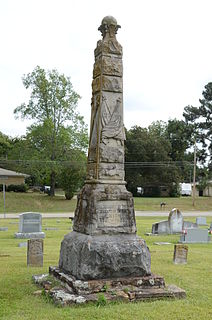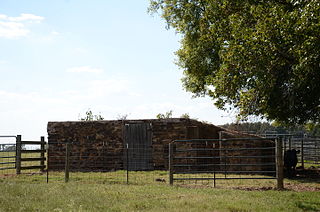Kelly House may refer to:

Arkansas Highway 385 is a designation for two state highways in White County, Arkansas. The southern segment of 8.98 miles (14.45 km) runs from Griffithville to Kensett. A northern segment of 6.23 miles (10.03 km) runs from Highway 367 in Judsonia to Plainview.

Highway 157 is a designation for two state highways in Northeast Arkansas. One segment begins at Highway 367 in Judsonia and runs north to Highway 14 near Oil Trough. A second, short industrial access road also carries the Highway 157 designation in Diaz. Both routes are maintained by the Arkansas Department of Transportation (ArDOT).

The Capt. John T. Burkett House is a historic house in rural Ouachita County, Arkansas. It is located at 607 Ouachita County Road 65, near the community of Frenchport. The 1+1⁄2-story wood-frame house was built c. 1899 by John Burkett, a ship's captain and part-owner of a local lumber mill. He later served as the chief warden at Cummins Prison, and then as a regional agent of the Internal Revenue Service. The house is a fine example of Folk Victorian style. Its front facade has a porch running across its whole width, mounted on piers made of locally manufactured bricks, with its hip-roof supported by concrete columns that resemble Tuscan-style columns. The balustrade is a metal filigree work. A gable-roof balcony projects above the center of the porch.

The Capt. Goodgame House is a historic house at 45 Highway 128 in Holly Springs, Arkansas. Built in 1918, this single story wood-frame house is an unusual late and high quality example of a vernacular style of house architecture more typically seen in 19th century construction in the area. It has a gable roof, and is clad in novelty siding. A porch extends across the front facade, supported by plain chamfered posts. The gable ends of the roof are extended, with full pediments, and the door and window surrounds are more elaborate than are typically seen in the area. The interior of the house follows a standard central hall plan, but the detailing is again of a particularly high quality.

The Capt. Charles C. Henderson House is a historic house at Henderson and 10th Streets in Arkadelphia, Arkansas. Built in 1906 and significantly altered in 1918–20, it is the largest and most elaborate house of that period on 10th Street. When first built, it was a 2+1⁄2-story hip-roofed Queen Anne style house with some Classical Revival elements. Its most prominent feature from this period is the turret with elaborate finial. In 1918-20 Henderson significantly modified the house, added the boxy two-story Craftsman-style porch. The house is now on the campus of Henderson State University.
The Capt. Isaac N. Deadrick House is a historic house on the west side of Arkansas Highway 163, a short way north of its junction with United States Route 64 in the community of Levesque, Arkansas. It is a two-story wood frame T-shaped structure, probably built around 1850 by the slaves of the father-in-law of Isaac N. Deadrick, a prominent early settler of the area who later served as captain of a cavalry company in the Confederate Army. It is the oldest known house in Cross County, and has been extensively altered, although much of its original structure is discernible. It is five bays wide, with a central entry on the main (eastern) facade that is flanked by sidelight windows and topped by a transom window. On the second floor above this entry is another door, which is probably original to the house.

The James W. Edie House is a historic house at Jackson and Washington Streets in Judsonia, Arkansas. It is a two-story wood-frame structure, with a side gable roof, weatherboard siding, and a stone pier foundation. A cross gable section projects from the center of the front facade, with a single-story porch spanning its width. It is supported by wooden columns with capitals at the top, and has decorative jigsawn balustrades and brackets. Built in 1883, it is one of White County's few surviving 19th-century houses.

The Grand Army of the Republic Monument of Judsonia, Arkansas is located in the city's Evergreen Cemetery, on Judson Avenue north of its downtown. The monument consists of a rusticated fieldstone base, on which a cubical stone with inscriptions has been set. This is topped by an obelisk-like tapering marble element with a square cross section, which is topped by a sphere adorned with floral detailing. It is set in a square area 31 feet (9.4 m) on each side, in which a number of Union Army soldiers are buried. The monument was placed in 1894 by the local chapter of the Grand Army of the Republic, a Union Army veterans' organization. White County, where Judsonia is located, was divided in the war, with men from the county serving on both sides in the conflict.
The Alfred W. Henson House was a historic house at 111 Main Street in Judsonia, Arkansas. It was a 2+1⁄2-story wood-frame structure, with elaborate Classical Revival styling. Its roof line and gable rakes were modillioned, and a gabled full-height entrance pavilion, supported by Ionic columns, projected from the main facade. Porches extended across the facade and around the side on both levels, with low turned balustrades. Built about 1884 and restyled in 1920, it was the city's finest residential example of Classical Revival architecture.
The Hoag House is a historic house in Judsonia, Arkansas. It is located on a wooded lot northeast of the junction of Arkansas Highways 157 and 367 in the northeastern part of the town. It is a rambling two-story wood-frame structure, with central section oriented north–south, and projecting gabled sections on the east and west sides. A two-story turret stands at the northeast junction of the main and eastern sections, topped by a pyramidal roof with gable dormers. A single-story porch with Victorian decoration wraps around the outside of the turret, joining the northern and eastern sections. Built about 1900, the house is locally distinctive for its central two-story box structure, and its Folk Victorian styling.

The Tobe Hoofman Farmstead is a historic farm property in rural White County, Arkansas. It is located on the west side of Arkansas Highway 13 north of Judsonia and Arkansas Highway 157. The property includes a farmhouse, wellhouse, barn, and storm cellar on about 40 acres (16 ha) of land. The farmhouse is a vernacular 1+1⁄2-story wood-frame building, with a gable roof and a hip-roof porch with small gables over its access stairs. The wellhouse is a small wood-frame structure with a hip roof; the storm cellar is an earthen structure, mostly below ground, with a small above-ground access building. The barn is a transervse crib wood-frame structure with a gable roof. The farmstead was developed about 1910, and is a little-altered example of an early 20th-century farmstead.

The Judsonia Bridge is a historic bridge, carrying Van Buren Street across the Little Red River on the south side of Judsonia, Arkansas. It is a three-span metal truss swing bridge, with a total structure length of 397 feet (121 m). Its center span is 266 feet (81 m) long, and is mounted on a pivot on a central pier. It and the two approach trusses are all Warren trusses. Built in 1924, it is one of three known swing bridges in the state, and the only one with a cantilevered swinging truss. It was closed to traffic in 2007, and reopened in 2013 after restoration.

The Judsonia Community Building Historic District encompasses the W.E. Orr City Park in Judsonia, Arkansas, as well as the community building. The park, which had been a public park since 1872, was the subject of a federal Works Progress Administration projects during the Great Depression, a project that also included the construction of the Colonial Revival community building.

The C.D. Kelly House is a historic house at Main and Adams Streets in Judsonia, Arkansas. It is a 1+1⁄2-story brick structure with Craftsman styling. It has a gabled roof, with a central projecting half-story that is also gabled. Gabled projections extend in several directions from the main block, with all of the gables and eaves exhibiting exposed rafters and large supporting brackets. Built about 1925, it is the city's finest example of the Craftsman style in brick.
The Emmett Miller House was a historic house in rural White County, Arkansas. It was located on the west side of Arkansas Highway 13, north of Judsonia and east of Plainview. It was a single-story wood-frame structure, with a gabled roof that had exposed rafters and Craftsman brackets in the end gables. Its front porch, also gabled, had similar features. It was built in 1938, and was the best example of Craftsman architecture in the Plainview area.

The Rock Building is a historic building in rural White County, Arkansas. It is located on the west side of Bartell Road, north of Judsonia and west of Arkansas Highway 13. It is a single-story stone structure, now lacking a roof, of uncertain original function. It was built about 1915, and originally had a gabled roof that extended over a porch. The building is unusual by virtue of its stone construction, which is rare for the period in the county.

The Jack Wood House is a historic house on Judson Avenue in Judsonia, Arkansas. It is an L-shaped wooden structure, clad in weatherboard siding, and presently exhibiting Craftsman styling, the result of a major restyling in c. 1924. The oldest portion of the house was built about 1890, and is a rare local example of box frame construction, with vertical planking as the main means of support, joined to the sills and rafters by square-cut nails. A more conventionally framed ell and the front porch were added about 1907.

The Capt. Archibald S. McKennon House is a historic house at 215 North Central Street in Clarksville, Arkansas. It is a two-story masonry structure, built of brick laid in common bond and covered by a flat roof. A two-story portico extends across its front, supported by slender tapered square columns. It was built in 1868 for a Confederate Army veteran and prominent local businessman and lawyer.
The Captain John T. Warner House is a historic house at 822 East College Street in Batesville, Arkansas. It is a 1+1⁄2-story wood-frame structure with a side-gable roof and clapboarded exterior. It has a gabled dormer at the center of the roof, with vernacular Eastlake style decoration. The house was built in 1879 by Captain John Warner. Warner was a prominent figure in local business and politics, serving as mayor of Batesville. He was instrumental in bringing about the electrification and provisioning of municipal water to the community.
















